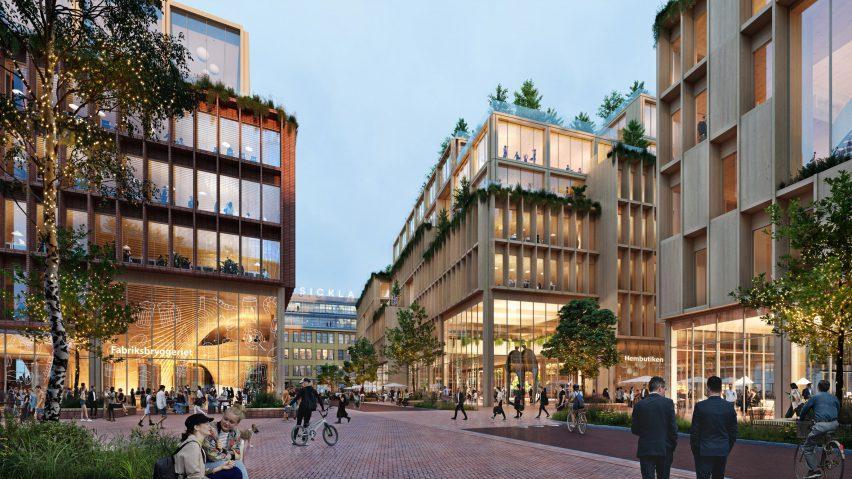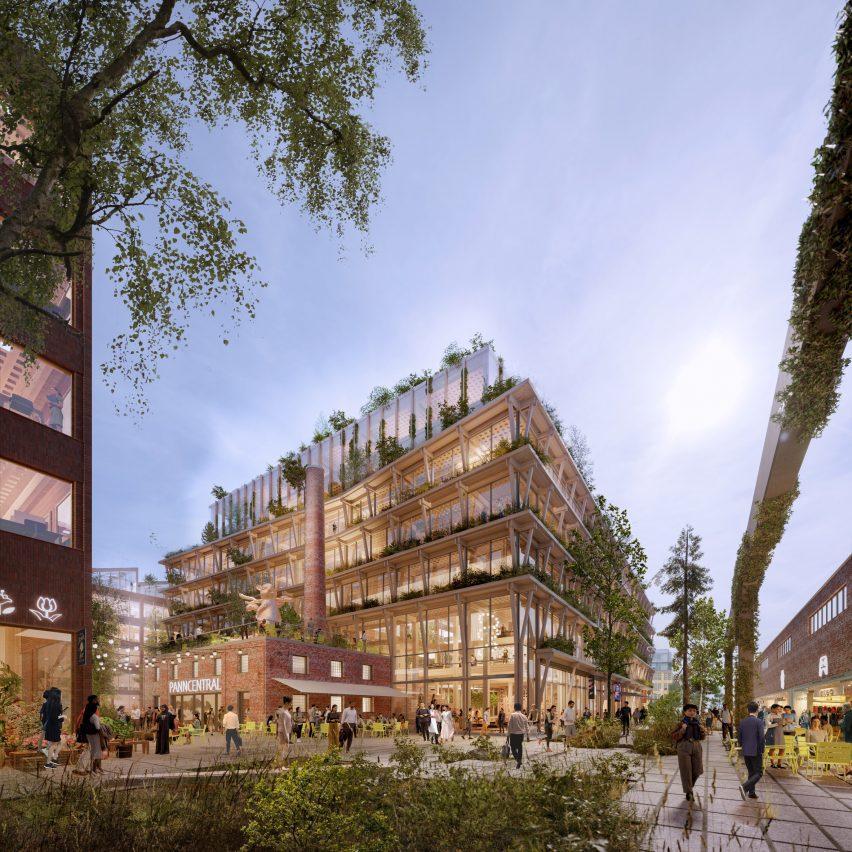An entire city made of wood?
While the world’s tallest wooden skyscraper has caught our attention, imagine the awe-inspiring vision of an entire city crafted entirely from the warmth and beauty of wood.
As concerns regarding climate change and environmental impact have escalated, there is an increasing preference for building materials with a lower carbon footprint. Wood, being a renewable resource that can be sustainably harvested and replanted, presents a more environmentally friendly choice. Moreover, advancements in prefabrication and modular construction techniques have simplified the process of constructing wooden buildings efficiently and within shorter timelines.
Architecturally innovative buildings made with wood composites, such as a college campus building almost entirely built of timber in Singapore and a 280-foot-tall timber skyscraper in Norway, have been gaining traction in recent times. In response to the growing demand for sustainable construction, Sweden is embarking on an ambitious construction project in the heart of Stockholm, planning to construct an entire wooden city scheduled to be completed by 2027.
Worlds largest wooden city- Stockholm Wood City
The wooden city, titled Stockholm Wood City, is the brainchild of Danish studio Henning Larsen and Swedish firm White Arkitekter. The development will cover 250,000 square metres, and as per real estate developer Atrium Ljungberg, it will be the world’s largest “wooden city”. The project will encompass 7,000 office spaces and 2,000 homes in the city’s southeast, creating a vibrant urban environment with workplaces, housing, restaurants, and shops.
Spanning an impressive 250,000 square meters (2.7 million square feet), it has been hailed as the largest known construction project in wood.The developer describes the area as a “five-minute city,” claiming that workplaces, homes, leisure facilities and amenities are all within a five-minute walk of one another.
Annica Anas, CEO of Atrium Ljungberg, said, “We are proud to introduce Stockholm Wood City. This is not only an important step for us as a company, but a historic milestone for Swedish innovation capability. Stockholm Wood City manifests our future.”


Stockholm City will feature 7,000 office spaces and 2,000 homes across over 250,000 square meters, a “mix of workplaces, housing, restaurants and shops
Why was wood selected as the building material for Stockholm Wood City and its importance?
The decision to primarily use wood as the building material is driven by several factors. Wooden buildings have been found to produce significantly lower carbon emissions compared to conventional construction materials in line with Sweden’s sustainability goals. To ensure sustainability, the project commits to planting at least two new trees for every one cut down, promoting eco-friendly building practices.
The demand for wooden construction has been steadily increasing due to various factors that make wood an attractive and sustainable building material. Some key reasons for choosing wood for this project include:
- Environmental Sustainability: Wood is a renewable resource that can be sustainably harvested and replanted, making it an environmentally friendly choice over non-renewable materials.
- Carbon Sequestration: Trees absorb carbon dioxide from the atmosphere during their growth and store it in the wood, effectively sequestering carbon and helping offset the carbon emissions associated with the building industry, contributing to carbon neutrality.
- Energy Efficiency: Wood has excellent thermal insulation properties, which can contribute to energy-efficient buildings. Timber structures can help reduce heating and cooling costs, making them a cost-effective and energy-saving option for construction.
- Prefabrication and Modular Construction: The advancements in prefabrication and modular construction techniques have made it easier to construct wooden buildings efficiently and with shorter construction timelines, offering cost savings and reduced waste during the construction process.
- Biophilic Connection: Humans have an innate connection to nature known as biophilia. Wooden construction creates a sense of warmth and connection to the natural environment, providing a more comfortable and nurturing living or working space.
- Speed of Construction: Wood construction is often faster compared to traditional methods, as prefabricated wooden components can be quickly assembled on-site.
Special features Stockholm Wood City;
Use of Scandinavian style aesthetic
The wooden city will showcase a distinct Scandinavian style, boasting several advantages over conventional construction methods. Using wood as the primary material will significantly reduce construction time and cut the environmental impact of the buildings by up to 50%, aligning with Sweden’s sustainability goals. The city aims to be self-sufficient in power production and storage further contributing to its eco-friendly approach.
The Scandinavian aesthetic with wood encompasses a design style commonly found in the Nordic countries of Scandinavia, including Sweden, Norway, Denmark, Finland, and Iceland. It prominently features wood as a primary material in interior and architectural design, reflecting the region’s deep connection to nature and its abundant forests. Key features of the Scandinavian aesthetic with wood include natural wood finishes, light and neutral colours, wooden floors and furniture, cosy textiles, natural light, greenery and plants, Scandinavian lighting, minimalist decor, hygge elements, handcrafted items, and functional wooden storage.
Thoughtfully incorporating these elements will create a harmonious and inviting space that captures the essence of Scandinavian style with wood, showcasing nature’s beauty while promoting simplicity and functionality.
Use of fire proof mass timber
The people behind the city said that all of the wood being used in the project will be fire-proofed mass timber and that the overall development will display the “serenity of a forest” and natural elements will also be part of the buildings.
“We sought to create an urban environment infused with the serenity of a forest, resulting in a dense, open space that bears the distinctively minimalistic and functional aesthetic of Scandinavian design,” Atrium Ljungberg , said.
Fireproof mass timber refers to engineered wood products that have been treated to enhance their fire resistance. Mass timber includes products like Cross-Laminated Timber (CLT), Glue-Laminated Timber (Glulam), and Laminated Veneer Lumber (LVL) have become popular in modern construction due to their sustainability, strength, and fire-resistant properties. These products can be prefabricated off-site, which speeds up the construction process. This reduces on-site waste and disturbance, leading to a cleaner and more efficient building site. Additionally, these products are engineered to possess high structural strength and performance. They can withstand heavy loads and are frequently used as load-bearing elements in tall buildings and large structures
With the building and construction industry contributing to nearly 40% of global emissions, there is a compelling climate case for mass timber construction, which involves various engineered wood products, reducing emissions associated with manufacturing, transportation, and installation by up to 26.5%.
Stockholm Wood City meeting fire safety requirements
Regarding “Stockholm Wood City,” Annica Ånäs, CEO of Atrium Ljungberg, stated that the project meets high safety requirements, including fire safety. She emphasised on how wood used is “specifically designed for its purpose,” citing how engineered wood forms a protective char layer on the surface that retains much of its structural strength, “contributing to a safer structure.”
She further mentioned that in the U.S., interest in modern timber building, such as wooden skyscrapers and large timber structures like the nine-acre timber airport roof, has been steadily growing. Fast Company reported around 1,300 mass-timber buildings under construction or developed across the country last year, with this number expected to rise as cities adapt their building codes.
Atrium Ljungberg’s Ånäs, believes that we will see more such mass timber projects worldwide.’ People need to witness successful examples like “Stockholm Wood City” to be inspired to adopt this innovative construction approach’, she added.

Researchers are concerned on the use of wood for an entire city
Some researchers still argue that the use of mass timber in building projects may result in a production process that emits more carbon than previously understood, due to a lack of comprehensive data on the total carbon impact of mass-timber buildings. There is also concern about the lack of clarity and consistency in fire safety regulations, as architect proponents need to improve their understanding of fire safety to avoid potential disasters. This issue arises from the lack of a consensus across different building code jurisdictions about safety limitations.
Raising question about building codes
‘Constructing an entire city made entirely of timber is unlikely in the near future’, Urban Institute researcher Andrew Rumbach said. He points out that building codes, often rooted in past urban fires, would need significant updates. Moreover, geography poses another barrier, as an all-wood city would likely need to be in a region with relatively low wildfire risk.
“There was an era where we built cities out of wood, and cities burned down,” Rumbach told noting that many building codes would have to first be updated, as a good portion have their origins in urban fires’, he said,
Another barrier to a “Stockholm Wood City” replica popping up in the U.S. is geography, according to Rumbach, who studies housing and community risk to hazards and climate change.
“Where are you going to build an all-wood city? It’s probably going to need to be somewhere where there is relatively low risk from wildfire, because you wouldn’t necessarily want an all-wood city in a wildfire-prone region, ” Andrew Rumbach further said.
Optimistic about adoption modern mass timber
On the other hand, Katie Mesia from Gensler, a global architecture and design firm, is optimistic about the likelihood of an American version of Sweden’s “wood city.” She sees a growing interest in modern mass timber building, spreading rapidly in Europe and increasing in the U.S.
She noted that the development project is the latest example of a growing “tidal wave” of interest in modern building with mass timber, spreading more rapidly across Europe, but also increasing within the U.S. The bottom line: “I am convinced that we will see more such projects across the world,” she added.
Conclusion
Experts remain optimistic about the adoption of modern mass timber construction. Interest in wooden skyscrapers and large timber structures is growing, and successful projects like “Stockholm Wood City” are likely to inspire more similar initiatives worldwide. As the construction industry seeks more sustainable solutions, mass timber’s advantages and its potential to reduce emissions make it an attractive choice for building projects.
References: axios.com, hypebeast.com, firstpost.com/.mtv.com.lb/en/news


